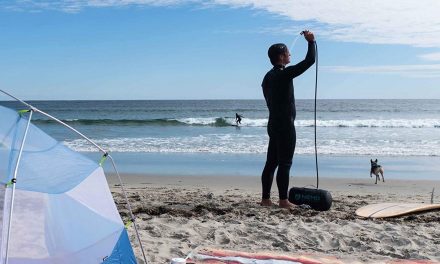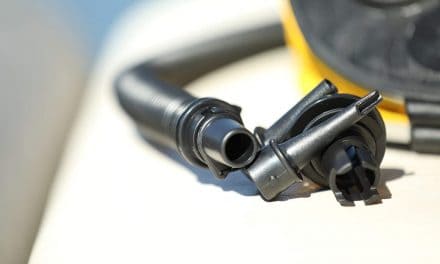Bell tents are becoming all the more popular these days, particularly among people who like a bit of luxury in the outdoors. But, what exactly is a bell tent and what are they for?
A bell tent is actually one of the oldest forms of outdoor living shelters. They feature a single central pole and are made with a heavy-duty cotton canvas fabric. These tents are durable, waterproof, and provide a spacious interior for a comfortable camping experience.
If you’re not quite sure whether this is the right shelter for your next camping trip, we’re here to help. Coming up, we have all the information you need to become a veritable bell tent expert.
What Is A Bell Tent Shaped Like?
A bell tent has a unique and easily identifiable shape, thanks to its single, centralize pole design. The traditional version of this shelter has a cone shape at the top and has 2-3 foot (0.6-0.9m) high straight-sided walls at the very bottom.
These days, though, there are some new shapes available for people with more specific camping needs. For example, you can get a bell tent in the following styles:
- Star Shape: These shelters have the traditional bell shape but feature large canopies around the sides to provide more protection from the elements. They also have additional guylines, which make them more stable in the wind.
- Yurt-Style. A yurt (or “ger), is a traditional type of portable tent that’s used all over central Asia. Although you can buy traditional yurts, some bell tent companies now make their shelters in a yurt-style. This means that they have high walls and flatter roofs for added interior living space.
Are Bell Tents Good?
Bell tents (such as the DANCHEL tent) are a good choice for certain types of camping, particularly in campgrounds or luxury camp environments. But, do they really live up to expectations?
Advantages Of A Bell Tent
Here are some of the benefits of using these shelters:
- Spacious. The main reason why people choose this style of camping tent is that it offers a whole lot of interior space, enough to rival even the largest of family tents. With all this added space, you can bring along comfortable camping cots, lots of extra gear, and all of life’s little luxuries.
- Durable & Waterproof. The vast majority of bell tents are made from cotton canvas. This type of tent fabric is highly durable and very waterproof. It’s also UV-resistant for use in very sunny conditions.
- Breathable. Cotton canvas tents are very breathable, so they’re ideal for use in hot climates.
- Warmth. While canvas is breathable, it’s one of the few fabrics out there that’s also very warm. Plus, most bell tents are compatible with a wood stove, which makes it easier to stay warm during the winter.
- Easy Set-Up. This style of tent is designed to be easy to set up, even for a solo camper. In fact, most of these shelters that are under 15 ft (5m) can be pitched by just one person.
Disadvantages Of A Bell Tent
However, like any piece of gear, bell tents do have their drawbacks. These are some of the disadvantages of bell tents that you should consider before purchasing one for your own adventures:
- Price. Unfortunately, most bell tents are quite pricey, with prices that are sometimes as much as 2-3 times the cost of a backpacking tent. While they have a big upfront cost, though, they are durable enough to last for years, so they are often the most cost-effective option.
- Lack Of Windows. The majority of these tents don’t have full windows because they have such short walls. Although they will have large vents, they’re not ideal for stargazing or taking in the view.
- No Separate Living Spaces. The interior of these tents is just one large open space. This is ideal for small groups or couples but isn’t always the best for people that want a lot of privacy and their own personal space.
- Heavy. These tents are quite heavy (upwards of 80lbs/36kg). So, they’re not exactly a good choice for backpacking.
- Low Entrances. Most bell tents have fairly low entrances and doors. This can make them tricky to use for people with limited mobility that have difficultly bending down. If this is the case, a yurt-style tent might be the better alternative.
Can You Live In A Bell Tent?
If you’re interested in living outdoors full-time, a bell tent is certainly an option. People have lived in these shelters around the world for centuries and many still do. They were actually used quite extensively throughout the Crimean War to house soldiers for extended periods of time.
These tents make for an ideal outdoor living shelter because they offer lots of interior space. They are tall enough to stand upright in and can usually be heated in the winter with a portable wood stove.
However, living in a bell tent isn’t like living in a regular house. Unless you have a property that’s set up with water and electrical hook-ups, you have to be prepared to live off the grid in your shelter. If that sounds like a nice way to live, though, then these tents are a solid choice.
How Do You Waterproof A Bell Tent?
Waterproofing a bell tent is all about maintaining the cotton canvas’s natural waterproof properties. But, while you might use Nikwax or other types of seam-sealer to treat a nylon tent, these products generally shouldn’t be used on canvas.
This is because silicone and plastic-based products will stop the canvas fibers from naturally expanding and contracting. The natural expansion of canvas fibers is what gives them their waterproofing properties.
Instead, canvas wax is the best option for canvas tents that start to leak after frequent use. This is a fairly time-consuming process but is important to do once in a while to keep your tent in good condition.
Bell Tents: A Glamper’s Home Away From Home
Bell tents are a fantastic option for anyone that enjoys some luxury camping in the great outdoors. Like all shelters, they have their pros and cons, but when it comes to overall quality and comfort, these tents are hard to beat.
- Tint Colors Explained For Polarized Sunglasses - November 19, 2022
- Top 4 Best Portable Camping Showers of 2022 - November 19, 2022
- How to Choose Water Shoes & What to Look For - November 18, 2022






